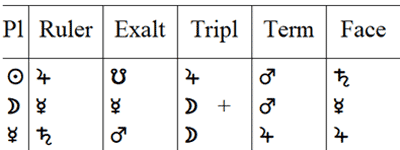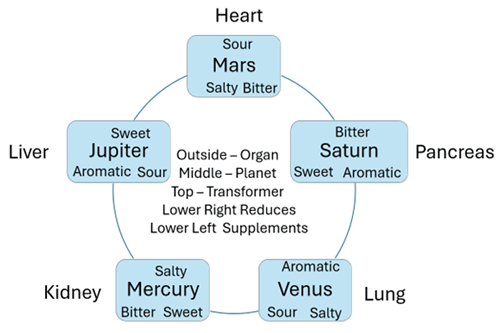William Morris explores astrology in terms of what the soul is through cultures and history. Part 2 in this series includes European Renaissance, Middle Ages astrology, Eastern vs Western astrology, Nicholas Culpeper's heuristics, and planetary dignity.
European Middle Ages
The tripartite Soul of the early Greek period retains a presence in astrological works up to and including the early modern period. Antonius de Montulmo recommends assessing a tripartite Soul, clearly in alignment with the views of Plato and Aristotle. [12]
The Almuten, or dominant dignity ruler, determines the tripartite Soul over the Sun, Moon, and Mercury. The sign expresses according to the conditions of its lord. Some schools replace Mercury with the Ascendant. If two of these Almutens are of equal power and are conjunct, that which is elevated above the other, has more significance.[13]
The Soul in the Renaissance and the Early Modern Period
The astrological discourse of the Renaissance regarding medicine tends to focus on pathology. However, the Neoplatonist translator for the Medici family, Marsilio Ficino (link to UT biography), addresses soul issues in depth, retaining the Platonic views relative to the tripartite Soul and expanding into the planetary considerations as the humoral factors of choleric, melancholic, phlegmatic, and sanguine effects. He is also famous as an apologist for the melancholic constitution (Ficino, Kaske, & Clark, 1989). [14]
As a translator of the Platonic and Hermetic corpus, Marsilio Ficino profoundly influenced the concept of the Psyche in the West. Here is a small sample:
What gathers showers, what the glazen hail; What are the seeds of gold, what of Iron; whence cruel thunder, whence the fountains of continual waters take their beginning, and such like other things. Let tender youths in their minority learn that philosophy; and everywhere avoid the doting fables of those philosophers who hold the world to be animal, and that it consists of innumerable animals, and those divine. What is more vain, what is more idle? For what else is it to say, the Sun is animated, or the celestial bodies are animated, and participating of the divine mind, than to fall into an evil heresy, and the abominable falsehood of idolatry? Neither is it to be granted (witness St. Augustine) that those sidereal globes doe live by certain minds of their own, and those intellectual and blessed. I doe certainly know that only a human soul is divine light, created according to the image of the word, the cause of causes, and the first pattern; markest with the substance of the seal of God: and whose impression is the eternal word. By a participation of which we believe the brutal Soul to subsist, taken out of the bosom of nature, seeming to have a slender similitude and small footstep of a rational Soul, as the echo is the image and resemblance of a living voice. But let others look after the vegetable soul (Ficinus, 1702/2011p. 172-183).
Ficino recognized the need to baptize his generation's traditional, orthodox religious values with Soul-infused waters, as his complete translation of the Platonic corpus witnessed the conjunction of Saturn and Jupiter (1484). This accomplishment signified a synthesis of formal tradition. It inspired revelation for Ficino, who also understood Saturn with Jupiter to represent the Platonic unity of wisdom and worldly Power, an ideal held by his patron and friend Lorenzo de Medici (Voss, 1992).
Ficino did not limit himself to astrological analyses. In his Three Books on Life, his missives on sound, scent, and lifestyle as a means to manage Psyche and her concerns were significant and formed a foundation for the modern era of psychology (Kaske, 2019). He also downplayed his commitment to the astrological community when confronted by polemics espoused by contemporaries such as Giovanni Pico della Mirandola.
Later medical astrologers from Culpeper to Saunders did not address the matters of spirituality. I suspect this omission may be due to the church-state's attempt to control such concerns of thought. After all, it had not been that long since Galileo was under house arrest and Giordano Bruno was burned at the stake for espousing heliocentric awareness.
East-West Intersectionality
The Assyriologist Carl Bezold states that he can discern Babylonian influences on the works of the great Chinese historian and court astrologer Sima Qian (c. 145 – c. 86 BCE) (Pankenier, 2014). Given this knowledge, it is likely that trade and knowledge exchange was taking place between East Asia and Europe long before the Silk Road. Such exchanges would seem to be ever-present, with occasional trade gaps and shared knowledge.
The blossoming of the philosophical traditions of Greece had parallels with China during the same period of the Han Dynasty. The emergence of medical systems in the Han dynasty was partly due to the development of new constants for the length of vehicle axles, which led to road building and more integrated transportation networks within the empire. These same mechanical breakthroughs eventually influenced the evolution of the Silk Road and other trade routes by facilitating travel and knowledge exchanges between East and West.
The Physician's Pulse Watch by Floyer dealt with reconstruction and criticism of Galen's approaches to pulse. What is fascinating is that the second half is a treatise on Chinese pulse diagnosis (1707), providing evidence of mature knowledge exchange between East and West. Table 2 (below) provides a general comparison at a threefold level.
Table 2 – The Tripartite Soul and the Three Treasures
This table derives from the Heshang Gong Commentary on Lao Zi's Dao De Jing, including references to the planetary assignments discussed in the Simple Questions (2015).
| Planet | Homer | Herophilus | Plato | Aristotle | Freud | Three Treasurers |
|---|---|---|---|---|---|---|
| Mercury | Psyche | Reason/Brain | Rational | Rational | Superego | Spirit |
| Sun/Asc | Thumos | Thumos/Heart | Thumos | Animal | Ego | Vitality |
| Moon | Appetite/Liver | Appetitive | Vegetative | Id | Essence |
There are many forms of mind, including anger mind, worry mind, intellectual mind, calm mind, and agitated mind. Thus, the term Spirit or Shen encompasses all the forms of soul expression. I use the table of dignities for the three planets' correlations in Table 2 to assess excess and deficiency. Thus, high dignity equals excess and weak dignity correlates with excesses and deficiencies of corresponding organ and tissues.
Soul Assessment
Essential dignity refers to the essence of a location, whereas accidental dignity refers to the circumstances. Accidental dignities help establish the scenarios and context within which the native finds him or herself. In a sense, the accidental dignities provide for circumstances of the 'socially constructed self.' Thus, for the Soul, the most critical feature of the analysis is essential dignity.
For most practitioners in the European tradition, the expression of the Soul takes place through the planet with the most significant amount of essential dignity, or the Almuten of the chart. Here, we limit the inquiry to three planets. Calculate the dominant planetary ruler for each column in Table 3 – Dignity Related to Soul for the Sun, Moon, and Mercury (below). The planet with the most points is the significator of the Soul. For this significator, explore the nuances of each planetary ruler in its row on the Table of Dignities (Table 6, Part 3).
Astrologers often use a limited set of rules for purposes of judgment. One may use the combination of the Moon, Sun, and Asc. However, Ptolemy sets forth a limitation whereby Mercury represents the rational Soul. The Moon is the appetitive (animal) soul. A vibrant, passionate soul or thumos is expressed and assessed by the Sun (see Table 3).
Table 3 - Dignity Related to Soul

For example, in Synopsis Medicinae, William Salmon evaluates the triplicity ruler of a given object to understand the related interior soul experience. It works very well for the cardinal sins, assessed in the 6th house via the dignities of its house cusp.[15]
In fiery signs, the cause is violent exercise or labor or heat of the fire or Sun
In earthy signs, it shows gluttony, surfeit, cold
In the air, the cause is troubles or fancies of the mind
In water, the etiology has drunkenness, repletion, surfeit, or taking of some inordinate cold at the feet, women, and things cold and sweet
~ Salmon, 1671, chapter XXIII
One of the most significant contributors to thought on the Soul and its treatment is Paracelsus, whose idea of the Archae as a single field of qi becomes the basis for his conception of the Soul living in each organ (Hartman, 1887, reprint ed. 1985).[16]
Culpeper's Heuristics
Heuristics are an experience-based technique for problem-solving, learning, and discovery. Nicholas Culpeper provides one of the more commonly used records for associating plant functions with planets and flavours. His heuristics include flavour, color, organotropism, and environmental location, all of which are tools for classification and knowledge of plant functions.
Morphology refers to the shape of a plant. For instance, Mars will resonate with thorny plants such as Rose and Blackthorne. The flavour of a plant suggests function as well. Then certain medicinals are attracted to various organs, such as Hawthorne berry for the heart and dandelion for the liver. Plants that proliferate in public spaces are considered more beneficial for common conditions than rare ones. As another example of location, those plants that grow in marshy areas will often have a good effect on fluid pathologies such as edema.
These practices, the Doctrine of Signatures, were abandoned during the Enlightenment. The belief in repeatable constants as factors of evidence during the 'enlightenment' became a driving force for the dissolution of this worldview. The logical error was to investigate the Doctrine of Signatures as veritable truth rather than as a loose set of heuristics for guiding inquiry and organizing thought. Flavours express in the body as a vital movement. Many herbal traditions use the concept of flavours to manage treatment strategies (Culpeper, 1655).
Taste and Astro-Herbalism
Multiple texts from the Canons of Chinese medicine use the number five as a flexible taxanomic system. The Yellow Emperor's Classic identifies the five planets in relationship to the five elements with an organizing principle for the five souls. The Soup Classic has five flavours, also classified by the five elements (Zhang, 2015). These five elements of Chinese medicine are used in a 'doctrine of correspondences,' where sets of related factors such as organs, colors, directions, and flavours form logical clusters that apply to various circumstances. Chapter 23 Wide Promulgation of the Five Qi discusses the five flavours, organs, and their pathologies.
"These five [tastes], respectively pungent, sour, sweet, bitter and salty, each possess their respective benefits, or through dispersing, or astringing, or moderating, or tightening, or firming, or softening, contingent upon the four seasons and the five solid organs, diseases are to be treated through the indicated five tastes…" Yellow Emperor's Classic
The temperature[17] and virtues of plants serve to heal and sustain health. There are two paths; my teacher Jiangfu Jiang often said, "Herbs are easy; we eliminate evil or benefit the righteous." In my practice, I reduce planets with strong dignity and supplement those with weak dignity.
The anonymously written text entitled The Soup Classic (Tang Ye Jing Fa ) has gripped the attention of scholars and classically informed herbal medicine practitioners (Zhang, 2015). In that text, the five flavours are applied to the five phases, which I correlate with the five visible planets as the agents of transformation.
Fig. 1: Diagram of the Five Phases of Soul Flavours

Notice that the reducing taste for one planet becomes the transforming taste for the next planet along the cycle, using a diurnal (clockwise) motion. Transformation is a function of vitality, including organ function and movement. The bodily basis for soul function, enhancing the transformative capacity of a taste associated with a planet, can help people remediate stagnation in a particular area of their life.
The Soup Classic describes three flavours for each of the five elements. One flavour each of supplementing, draining and transforming takes place for each element. This model's transformation is rooted in the planet or element one seeks to remediate. Thus, bitter, salty, sour, pungent, and sweet take on different functions based on context.
Go to Part 3: Soul Flavours: Operating the Method
Go to Part 1: Soul Flavours: Essential Dignity as a Tool for Remediation
Gratitude
The author would like to express the deepest gratitude to Scott Silverman for his editorial assistance, while taking full responsibility for any and all errors of grammar, linguistics, and rationale. Further appreciation goes to my teacher Lee Lehmann who encouraged me to embark on this paper, I hope that my departures from tradition are not disturbing and that there is sufficient explanation.
William Morris, DAOM PhD
William Morris is a medical astrologer who gave his first consultation in 1977. He is practicing in the Kootenay Lake District of British Columbia. His background includes a master's degree in medical education from the University of Southern California, a clinical Doctorate and Acupuncture and Oriental Medicine, and a PhD in transformative inquiry focused on practice-based knowing. Will has published books on TCM and astrology and has 43 years of clinical experience using astrology as a feature of practice. During the 1990s he focused his practice on the methods of Lilly and Culpeper with 40 patients a week. He also used sidereal, cosmobiology, and Jyotish methods during that period. His work is a creole blend of music, astrology, medicine, and magic.
Endnotes for Part 2
[12] Luminaries of the Middle Ages include Abu 'Ali al-Khayyat, Abu Ma'shar, Bonatti, Gaurico, Ibn Ezra, John Dee, Messahallah, Montulmo, Morinus and Placidus 800 AD to 1500 AD.
[13] The highest planet is closest to a 900 angle in the sky above the Asc. This is called a 'nonagesimal’ and may not be reflected as the Midheaven. Sometimes I will choose the nonagesimal over the Midheaven (the most southern point) as the primary significator of therapeutic outcomes. If there is a planet occupying the nonagesimal, I may give It primacy in therapeutic strategizing, but this is my practice and not a part of the Tradition.
[14] The Renaissance is a field of influence from around 1450 AD to 1700 AD. Luminaries include Marsilio Ficino, William Lilly, Nicholas Culpeper, Johannes Schoener, della Mirandola, Regiomontanus, Placidus, Morin, Kepler, Galileo, and John Dee.
[15] The sins are associated with the 6th house in the Jyotish lineage of Sanjay Rath.
[16] Rupert Sheldrake calls the Archae the morphic field, and these ideas have their roots in a Neoplatonic view of the cosmos.
[17] Traditional herbal systems identify temperature as a factor. It is not temperature by measuring the actual temperature of a plant, a logical error incurred during the Enlightenment. The effects of warming may be through sensations in the mouth or in local tissues through vasodilation or cooling by constriction. There are many factors for another treatise.

